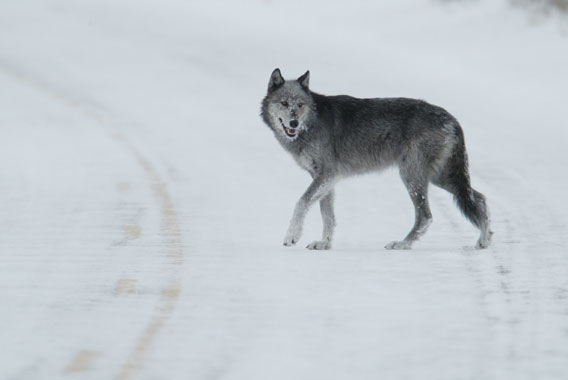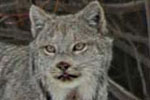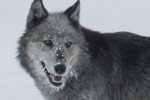
Wolf in Yellowstone National Park. Photo courtesy of Yellowstone National Park.
Hunters and trappers have killed approximately 1,530 wolves over the last 18 months in the contiguous U.S., which excludes Alaska. After being protected under the Endangered Species Act (ESA) for 38 years, gray wolves (Canis lupus) were stripped of their protected states in 2011 by a legislative rider (the only animal to ever be removed in this way). Hunting and trapping first began in Montana and Idaho and has since opened in Wyoming, Minnesota, and Wisconsin.
In Minnesota’s first season of wolf hunting since the species lost their protected status, hunters and trappers killed 412 wolves, slight above the state’s ceiling of 400 wolves. Before the hunting, Minnesota was estimated to have around 3,000 wolves, the most in any state other than Alaska which houses upwards of 7,000 wolves.
During Wisconsin’s first season, hunters and trappers killed 117 wolves. Before its kick-off, it was estimated that 850 inhabited Wisconsin’s forest, but the state has established a policy to cut down this population to just 350 wolves and keep it there.
In the western U.S., the total has hit just over 1,000 animals since hunting began in Montana and Idaho in late 2011, according to the Defenders of Wildlife. Three hundred and forty-five wolves have been killed in Montana in the last eighteen months, 582 in Idaho, and 74 in Wyoming.
Gray wolves were decimated by hunting, trapping, and poisoning throughout the 19th and early 20th Century, until the only survivors in the contiguous U.S. were in northern Minnesota. Wolves re-entered the western U.S. from the Canada, with packs moving into Glacier National Park before scientists began re-introduction efforts further south in Yellowstone National Park in 1995. Since then the highly resilient species has moved into Oregon, Washington, and California. Meanwhile, protection under the ESA allowed Minnesota’s wolves to expand into Wisconsin and Michigan.
Michigan, which has an estimated population of 680 wolves, is now debating whether or not to open up a wolf season.
As top predators, wolves play a massive role in ecosystem health according to scientists. The re-introduction of wolves into Yellowstone National Park allowed forests to recover after decades of over-browsing by unafraid elk herds. Elk responded to the return of the wolf with what scientists dub “the ecology of fear”: they stopped browsing along streams or out in the open, and instead spent more time in deep forests. The return of riverside bushes and trees improved songbird populations and allowed long-absent beavers to return. Shade from the burgeoning trees have cooled streams—leading to less evaporation—while beavers have created in fish habitat.
Related articles
Controversial wolf hunt moves to the Midwest, 196 wolves killed to date

(11/14/2012) The hugely controversial wolf hunt in the U.S. has spread from the western U.S. (Montana, Idaho, and Wyoming) to the Midwest (Minnesota and Wisconsin) this year. Although the wolf hunt is less than a month old in the region—and only eleven days old in Minnesota—196 animals so far have been shot. As in the west, the wolf hunt has raised hackles among environmentalists along with fierce defenders among hunters. Wolves, which were protected under the the Endangered Species Act (ESA) since 1973, were stripped of that status by legislation in 2009, opening the door—should a state choose—to trophy hunting.
Over 450 wolves shot dead in Idaho, Montana to date

(02/27/2012) Less than a year after being pulled off the Endangered Species Act (ESA), gray wolves (Canis lupus) in the western U.S. are facing an onslaught of hunting. The hunting season for wolves has just closed in Montana with 160 individuals killed, around 75 percent of 220-wolf kill quota for the state. In neighboring Idaho, where 318 wolves have been killed so far by hunters and trappers, the season extends until June. In other states—Oregon, Washington, California, and Utah—wolf hunting is not currently allowed, and the species is still under federal protection in Wyoming.
The heroic wolf: are wolves the key to saving the Canada lynx?

(08/31/2011) In 2000 the Canada lynx (Lynx canadensis) was listed as threatened under the US Endangered Species Act (ESA). While remaining stable in Canada and Alaska, the Canada lynx population had essentially collapsed in much of the continental US, excluding Alaska. Aside from habitat loss, one of the main factors imperiling the medium-sized wild cat was a decline in prey, specifically snowshoe hares (Lepus americanus). Researchers have now come up with an innovative way to aid hungry lynx in the US: wolves.
Decline in top predators and megafauna ‘humankind’s most pervasive influence on nature’

(07/14/2011) Worldwide wolf populations have dropped around 99 percent from historic populations. Lion populations have fallen from 450,000 to 20,000 in 50 years. Three subspecies of tiger went extinct in the 20th Century. Overfishing and finning has cut some shark populations down by 90 percent in just a few decades. Though humpback whales have rebounded since whaling was banned, they are still far from historic numbers. While some humans have mourned such statistics as an aesthetic loss, scientists now say these declines have a far greater impact on humans than just the vanishing of iconic animals. The almost wholesale destruction of top predators—such as sharks, wolves, and big cats—has drastically altered the world’s ecosystems, according to a new review study in Science. Although researchers have long known that the decline of animals at the top of food chain, including big herbivores and omnivores, affects ecosystems through what is known as ‘trophic cascade’, studies over the past few decades are only beginning to reveal the extent to which these animals maintain healthy environments, preserve biodiversity, and improve nature’s productivity.
(04/17/2011) A ‘rider’ attached to the most recent budget passed this week in the US congress has stripped gray wolves from the protection of the Endangered Species Act, a first in the law’s nearly 40-year-history. The rider, which was signed into law under the budget on Friday by US President Barack Obama, hands gray wolves (Canis lupus) in Montana, Idaho, Utah, Washington, and Oregon from Federal protection to state control. Hunting is expected to begin soon.
Egyptian jackal is actually ancient wolf

(01/26/2011) The Egyptian jackal, which may have been the inspiration for the Egyptian god Anubis, is actually not a jackal at all but a member of the wolf family. New genetic research in the open-access journal PLoS ONE finds that the Egyptian jackal is Africa’s only member of the gray wolf family. The new wolf, dubbed by researchers as the African wolf, is most closely related to the Himalayan wolf.
What do wolves and sharks have in common?

(11/15/2010) Sharks dwell in the ocean, wolves on land; sharks are a type of fish, wolves are a mammal; sharks go back some 400 million years, wolves only some 2 million years. So, these animals should have little in common, right? However, a new study in Frontiers in Ecology and the Environment points to surprising similarities among these disparate animals. As top predators, both wolves and sharks impact their prey and other species in similar ways.
Why top predators matter: an in-depth look at new research
(02/02/2010) Few species have faced such vitriolic hatred from humans as the world’s top predators. Considered by many as pests—often as dangerous—they have been gunned down, poisoned, speared, ‘finned’, and decimated across their habitats. Even where large areas of habitat are protected, the one thing that is often missing are top predators. However, new research over the past few decades is showing just how vital these predators are to ecosystems. Biologists have long known that predators control populations of prey animals, but new studies show that they may do much more. From controlling smaller predators to protecting river banks from erosion to providing nutrient hotspots, it appears that top predators are indispensible to a working ecosystem. Top predators sit at the apex of an ecosystem’s food chain. Wolves in Alaska, tigers in Siberia, lions in Kenya, white sharks in the Pacific are all examples of top predators.
